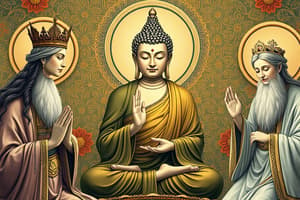Podcast
Questions and Answers
What historical event is credited with the spread of Buddhism from Northern India?
What historical event is credited with the spread of Buddhism from Northern India?
The Silk Road
How did the Silk Road impact the spread of Buddhism?
How did the Silk Road impact the spread of Buddhism?
It connected various cultures and fostered trade, resulting in cross-cultural exchanges.
What was the significance of the Gandhara art style in terms of globalization?
What was the significance of the Gandhara art style in terms of globalization?
It blended Greco-Roman and Indian elements.
What was the primary purpose of the First Crusade?
What was the primary purpose of the First Crusade?
How did the Crusades contribute to a shift in European socioeconomic landscape?
How did the Crusades contribute to a shift in European socioeconomic landscape?
What was the underlying cause of the Iranian Revolution in 1979?
What was the underlying cause of the Iranian Revolution in 1979?
What was the main focus of the Sikh separatist movement in Punjab during the 1980s?
What was the main focus of the Sikh separatist movement in Punjab during the 1980s?
What religious conflict in Sri Lanka inspired Buddhist activism in the 1980s?
What religious conflict in Sri Lanka inspired Buddhist activism in the 1980s?
What was the main ideological driving force behind the Afghan Jihad in 1980s?
What was the main ideological driving force behind the Afghan Jihad in 1980s?
How did the Afghan Jihad impact the later formation of al-Qaeda?
How did the Afghan Jihad impact the later formation of al-Qaeda?
What are the key themes in modern religious conflicts?
What are the key themes in modern religious conflicts?
What is the role of religious leadership in modern conflicts?
What is the role of religious leadership in modern conflicts?
How does religion contribute to security in a world marked by uncertainty?
How does religion contribute to security in a world marked by uncertainty?
What is the most common symbol used by Hamas leaders?
What is the most common symbol used by Hamas leaders?
What are the two main categories of migration?
What are the two main categories of migration?
What are the top three origin countries for global migrants?
What are the top three origin countries for global migrants?
What is the most common push factor driving migration?
What is the most common push factor driving migration?
What are the most common pull factors attracting migrants?
What are the most common pull factors attracting migrants?
What is a potential negative impact of large-scale migration on developing nations?
What is a potential negative impact of large-scale migration on developing nations?
What is the challenge posed by food security and global migration?
What is the challenge posed by food security and global migration?
Flashcards
Buddhist Globalization
Buddhist Globalization
The spread of Buddhism across Central Asia, China, Korea, Japan, and Tibet, facilitated by the Silk Road and missionary activities.
Silk Road & Buddhism
Silk Road & Buddhism
The Silk Road facilitated the exchange of Buddhist ideas and practices, along with trade, across vast regions.
Buddhist Economic Impact
Buddhist Economic Impact
Buddhist practices influenced trade networks by creating demand for silk and Buddhist relics, boosting cross-cultural exchanges.
Gandhara Art Style
Gandhara Art Style
Signup and view all the flashcards
First Crusade
First Crusade
Signup and view all the flashcards
European Colonialism
European Colonialism
Signup and view all the flashcards
Crusades' Economic Impact
Crusades' Economic Impact
Signup and view all the flashcards
Crusades' Social Impact
Crusades' Social Impact
Signup and view all the flashcards
Religion & State Synergy
Religion & State Synergy
Signup and view all the flashcards
Juergensmeyer's Stages
Juergensmeyer's Stages
Signup and view all the flashcards
Religious Resurgence
Religious Resurgence
Signup and view all the flashcards
Stage 1: Isolated Outbursts
Stage 1: Isolated Outbursts
Signup and view all the flashcards
Stage 4: Global War (Post-9/11)
Stage 4: Global War (Post-9/11)
Signup and view all the flashcards
9/11 Attacks
9/11 Attacks
Signup and view all the flashcards
Study Notes
Section 1: Religion as a Globalizing Force
-
Religion and state have historically collaborated to achieve both spiritual and secular goals.
-
Ancient and medieval times show a merging of religious and state interests, a pattern that continues in some states today.
-
Buddhism spread globally via the Silk Road.
- Westward: Buddhism spread to Afghanistan, Bengal, and Central Asia.
- Eastward: Buddhism spread to China, Korea, and Japan.
- Buddhism returned to Tibet and influenced regions like Kyrgyzstan and Tajikistan.
-
Buddhist missionary activities established Buddhism in remote regions.
-
Silk trade bolstered Buddhist trade networks, and cultural exchanges stimulated by Buddhist relics.
-
Artistic globalization: The Gandhara art style fused Greco-Roman and Indian elements.
-
The Buddha's depiction revolutionized Buddhist imagery.
-
Buddhist art influenced Central Asian and Chinese monastic and architectural styles.
Section 2: Christianity and the Crusades
- The First Crusade (1095) aimed to reclaim the Holy Land, which is considered an early example of European colonialism.
- Crusaders were motivated by territorial ambitions and economic incentives (trade routes).
- The First Crusade affected social dynamics within Europe due to peasant seeking economic and religious relief.
- Arab nationalists criticized the Crusades as imperialistic.
Section 3: Juergensmeyer's Stages of Religious Resurgence
- Religion responds to crises in globalization and secularism in distinct stages.
- Stage 1 (1970s–1980s): Isolated outbreaks, including the Iranian Revolution (1979), Sikh separatists in Punjab (1980s), and Buddhist activism in Sri Lanka.
- Stage 2: Internationalization of Religious Rebellion - Afghan Jihad (1980s), and United radical Muslims globally.
- Stage 3 (1990s-): Anti-Western Sentiment, focusing on global centers such as the US and Europe.
Section 4: Global War (Post-9/11)
- 9/11 attacks: Coordinated by global jihadist groups, marking a shift in religious conflict, intertwining with secular conflicts.
- A global "War on Terror" arose as a result of the 9/11 attacks, which impacted religious and secular conflicts around the world.
Section 5: Non-Violent Uprisings (Arab Spring)
- Peaceful revolutionary movements, such as the Tahrir Square protests in 2011.
- Protests by young, educated activists, emphasizing religious inclusivity.
- Demonstrated peaceful alternatives to violent jihadist tactics.
Section 6: Religion in Modern Global Conflicts (Themes)
- Identity: Religion serves as a cultural anchor amid globalization.
Section 7: Global Migration (Overview)
- Types of migration: Internal (within a country), and International (across borders).
- Key factors driving migration: Economic (higher wages), social (political/religious freedom), and environmental pressures (like rising sea levels).
- Migrants' impact: Economic (remittances), and the creation of more culturally diverse societies (but potentially cultural tensions).
Section 8: Global Migration (Challenges)
- Challenges of globalization include overcrowded urban centers and food security concerns.
- Possible strain on resources worldwide due to population growth.
- Cultural diversity can create tensions, as seen in anti-immigrant movements in Europe.
- "Brain drain" may negatively affect developing nations.
Studying That Suits You
Use AI to generate personalized quizzes and flashcards to suit your learning preferences.




